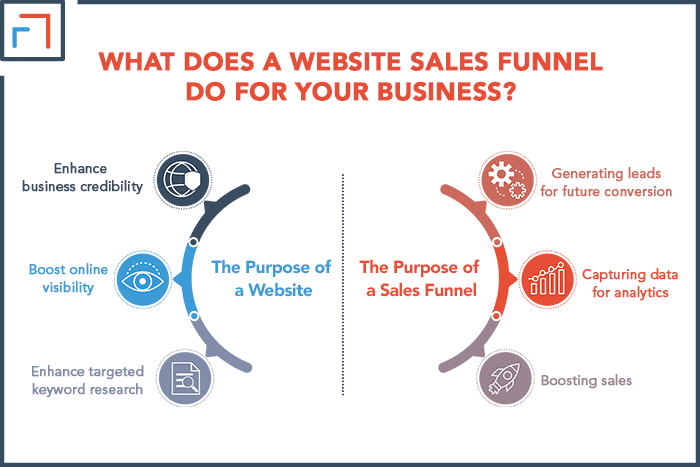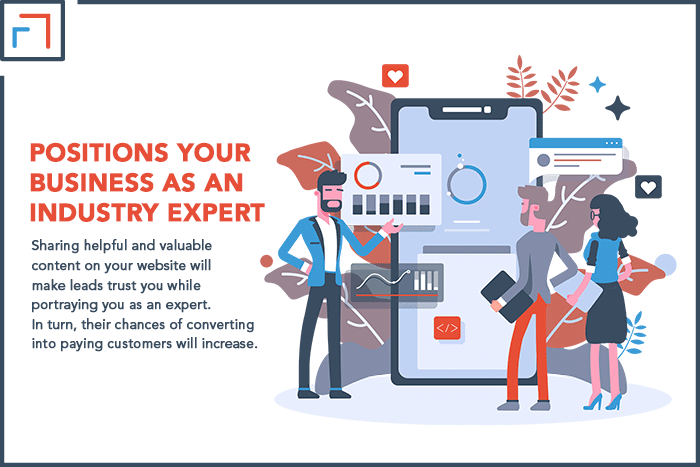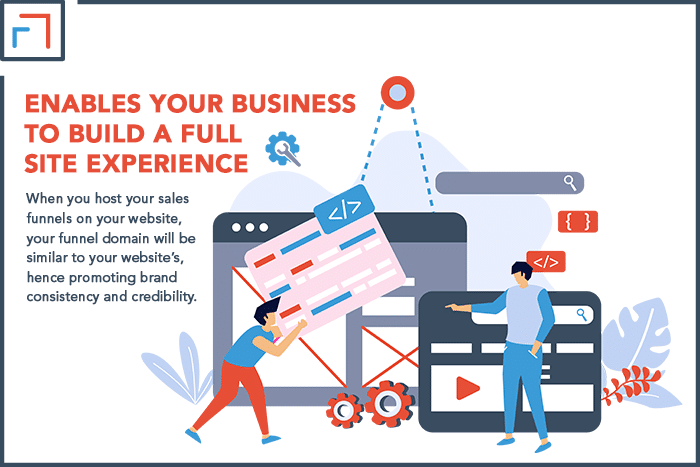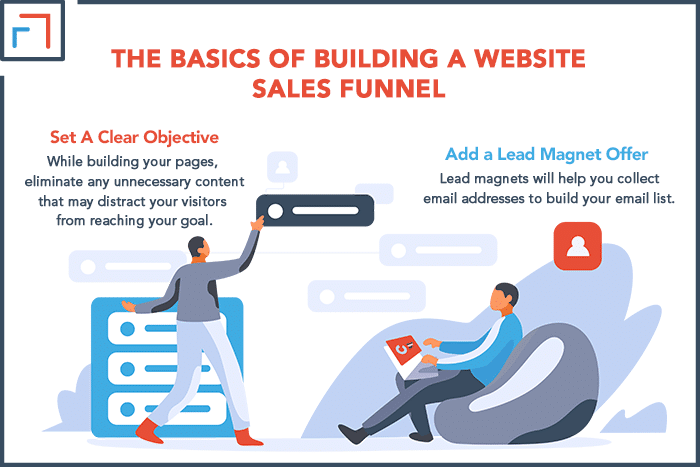Sales funnels are all the rage now because they efficiently convert leads and boost sales. On the other hand, websites may not directly push leads to make a purchase. As such, you may be wondering if you really need a website for your sales funnel to be effective.
In almost every case, you need a website for your sales funnel. While sales funnels boost conversions, their direct approach can be annoying. Thus, building sales funnels on your website makes funnels user-friendly and effective. Moreover, website SEO will improve the funnel’s visibility.
Sales funnels and websites are different, but they are both essential parts of a marketing strategy. In this guide, we’ll discuss the purpose of a website sales funnel, how your business could benefit from one, and how you can create your own.
What Does a Website Sales Funnel Do for Your Business?
Both websites and sales funnels can benefit your business.
Understanding the distinct strengths and weaknesses that each has to offer can help you decide whether you need a website for your sales funnels.
1. The Purpose of a Website
A website acts as a storefront for your business via an online address that enables people to find you on the web.
Moreover, a website serves as an information hub detailing what you do, providing information about your products, and offering deals.
Furthermore, your website can answer questions in the form of blogs, community forums, or FAQ sections.
Other forms of the content offered by websites include videos, images, and links to other sites.
Apart from answering questions and providing quality content, websites can also:
- Enhance business credibility
- Boost online visibility
- Enhance targeted keyword research
Websites act as general resources for anyone looking for information about your business.
Because of the broad appeal, traffic arriving on a website can scatter in any direction.
In the end, website visitors will navigate through several pages of the website and may end up leaving without taking any action.
This is where sales funnels come in since they are designed to fulfill a single end goal.
2. The Purpose of a Sales Funnel
A sales funnel walks a potential customer through a series of stages in the buying process. Throughout all the stages, the funnel prompts leads to take action.
Such actions include signing up for a newsletter, registering for a webinar, subscribing to a blog, and more.
The funnel works through an automated system that allows it to make connections, engage leads and follow up on them.
Thus, it acts as your salesperson. Other purposes of a sales funnel include:
- Generating leads for future conversions
- Capturing data for analytics
- Boosting sales
However, since funnels are geared towards singular goals, they do not offer additional information.
These are considered distractions that may hinder prospects from heeding a call to action.
Therefore, it may not help when a lead needs more information, and this is where a website comes in.
The two of them complement each other’s purpose. There may be a bit of overlap, but websites can do things that funnels cannot and vice versa.

So, Should You Have a Website for Your Sales Funnel?
The core agenda of any business is to make sales and boost the generated revenue. A sales funnel is an excellent tool for achieving that goal.
So, it makes perfect sense to wonder if you still need a website.
Although a website does not function the same way a funnel does when generating leads, it still has its perks.
As seen above, the two have distinct weaknesses and strengths. The best way is to use them together so they can complement one another.
For instance, while a sales funnel directs your audience to a single action, your website will answer any questions your audience may have.
Likewise, while your website can engage your audience through blog posts and events, your funnel will build relationships with them through a targeted path.
Consequently, your business will become an unstoppable force in your niche when you build your sales funnels in conjunction with your website.
Why Should You Build Your Sales Funnel on Your Website?
Building your sales funnel directly on your website helps you to use website pages as sales funnel pages. By doing so, your business benefits more.
Here are some of the perks of building sales funnels on your website.
1. Enhances Credibility
The widespread availability of information on the web has empowered the modern customer.
With a huge variety to choose from, consumers opt for credible businesses. As such, a website is your best shot at achieving credibility.
Since people are actively searching for businesses online, you can provide your business information on your website.
For example, you can highlight your products, services, hours, and location. Afterward, you can direct your leads to join a simple sales funnel on your site.
This usually happens in the form of an email opt-in box. Moreover, adding calls to action on your website is a great way to get leads to enter your sales funnel.
Consider every page, pop-up, or blog article an opportunity to target undecided visitors with your sales funnel.
2. Positions Your Business As An Industry Expert
A sales funnel does an excellent job of mapping out the customer buying stages. A website takes care of leads at the information search stage.
This is where leads learn more and compare products and companies before purchasing.
Leads will search for reviews, read blog posts, and look for other informational pieces online, especially those from industry experts.
That said, your website can help you share informative content to help push your leads further along the sales funnel.
Sharing helpful and valuable content on your website will make leads trust you while portraying you as an expert.
In turn, when leads trust you, their chances of converting into paying customers will increase.
Some of the content your website can showcase includes:
- Informational videos
- Blog posts
- Ebooks
- White papers
- Case studies

3. Helps People Find You and Boost Conversions
While a sales funnel converts faster when compared to a website, you will still make sales through your website.
So, combining the two will scale your conversion rates. Therefore, you should keep in mind that websites and social media play vital roles in the sales process.
If people cannot find your sales funnel will be of minimal use.
By building your sales funnels on your website, you increase the chances of people interacting with them.
In addition, you can improve your website’s ranking by optimizing it for search engines.
Search Engine Optimization and Search Engine Marketing best practices are among the top ways to help leads find you organically.
This involves using the industry keywords in your website and content. Using these words correctly can help your site to rank in online searches.
Even though most visitors to your website won’t convert right away, more people will convert over time. Bear in mind that the purchase process is now longer than before.
This is because most buyers spend huge amounts of time researching before making up their minds. Be patient and keep making great content and offers.
Ultimately, the key is to offer value-laden content so your visitors will remember you when it’s time to buy.
4. Connects With Leads and Builds Relationships
When people visit websites for the first time, they are searching for a resolution to their pain points.
Therefore, a website addresses their problems while also acting as a gateway to your sales funnels.
By answering your visitors’ questions, you get a chance to connect with them and build lasting relationships.
For instance, if someone visits your services page, you could provide them with a pop-up offering them a free consultation call.
Consequently, they will enter your free consultation call funnel.
Or maybe a lead who is seeking to learn more on your website could be directed to subscribe to your mailing list.
By joining your list for regular updates, they enter your sales funnel.
5. Builds Your Email List
An email list is your greatest asset when it comes to email marketing.
A website can help you get subscribers every now and then so you can grow your sales funnel email list.
The best part about subscribers is they help you gain repeat customers.
For this goal, your website will complement your sales funnel since the funnel may not help in retaining customers.
It is often cheaper to retain customers rather than to acquire new ones. Make sure you cater to both groups.
Sending regular email updates is essential whether you use a funnel or a website. Keep your subscribers engaged with new blog posts, special offers, discounts, and more.
6. Enables Your Business to Build a Full Site Experience
While you could build a sales funnel without a website, most funnel builders are not designed to support a full site experience.
Unfortunately, this means you will not be able to add crucial pages like blogs, eCommerce, or utilize SEO.
Moreover, you do not own the funnel pages the way you would if you purchased and hosted your own domain.
If you fail to pay, the software provider will deny you access to those pages.
This means you are stuck with the pages as long as you are still trading because canceling is not an option.
Similarly, transferring your funnel copy from one funnel builder to another is almost impossible unless you are tech-savvy.
You could try to outsource the transfer, but it is costly.
Additionally, you are creatively limited, so this will make your pages look like those of your competitors who are using the same software.
On another note, you will miss out on Google and Facebook advertising if you do not host your sales funnels on your website.
This is because both marketing giants need assurance that you are a reliable business with a multi-page website.
Finally, when you host your sales funnels on your website, your funnel domain will be similar to your website’s, hence promoting brand consistency and credibility.

How To Create a Website Sales Funnel?
Creating a website sales funnel is quite a process, but it is doable. Before you get started, you will need a few website elements.
In this overview, we’ll talk about creating sales funnels for WordPress, but you can connect with other websites as well. Here are the essential components you need.
1. A Reliable Hosting Provider
Your sales funnel website will need quality hosting for it to function optimally.
When choosing a hosting service, consider its key features such as support, server speed, control panel ease of use, and pricing.
Some of the most popular hosts include HostGator and Siteground.
2. A WordPress Theme
You will need a theme for your WordPress website. Depending on your budget, you can choose a free or paid theme.
Some of the most popular themes include Astra and Divi.
3. A Plugin to Convert Your Website Into an Online Store
For your website to support a sales funnel, you will need a checkout section. Fortunately, WordPress supports e-commerce, and it is widely used.
The most commonly used popular plugin is Woocommerce, and it is free to use.
This plugin allows you to merge several tools such as drop shipping, payment gateways, and membership tools.
4. An Excellent Page Builder
You will need a page builder to create pages on your sales funnel website.
Again, there are several page builders that you can use, but Elementor is one of the best page builders for WordPress. It has both free and paid versions.
5. A WordPress Funnel Builder
Finally, you need a funnel builder to create funnel pages on your WordPress website. There are several builders to choose from.
Cartflows is a great one that allows you to create several editable sales funnels.
Moreover, it comes with pre-made sales funnel templates so you can start creating funnels right away.
The Basics of Building a Website Sales Funnel
The basics for creating a website sales funnel include setting objectives and adding lead magnets to your pages.
1. Set a Clear Objective
When building a website sales funnel, you should always have an objective in mind. For instance, what would you like your audience to do upon visiting your page?
Once you have your desired goal, build your website pages around this objective. Finally, add a clear CTA for visitors to see.
While building your pages, eliminate any unnecessary content that may distract your visitors from reaching your goal.
However, this does not mean your website funnel should not be informative. For example, you can use a series of valuable blog posts and attach a CTA to each one.
2. Add a Lead Magnet Offer
Your website sales funnel wouldn’t be complete without a lead magnet. Lead magnets will help you collect email addresses to build your email list.
With subscribers, you can consistently market to a specific audience that’s somewhat interested in your business.
The key is to ensure your lead magnet is visible.
The simplest way to ensure visibility is through pop-ups. The pop-up will offer informative content in exchange for email addresses.
For example, you might use a video of exclusive tips from an industry expert.

Wrap Up
Although a sales funnel converts well on its own, it won’t be nearly as effective if you don’t connect it to a website.
Without a website, would-be customers won’t know if your brand is credible and reliable. You will also lose out on having exclusive ownership of your funnel pages.
Therefore, the key to a successful business is building a sales funnel on your website.
Using a funnel builder on your website will give you the best of both platforms.
Ideally, the more channels you have for attracting traffic, the more leads you will convert, and the more revenue you will generate.
